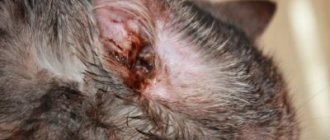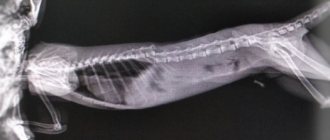Cats are, in most cases, selective about their food choices. Owners can spend a lot of time studying the preferences of their pets. By observing cats eating food, we can draw a conclusion. They slowly absorb food and do not eat what they do not like. The owners can only satisfy the requirements of the pet and monitor its health. The first sign that your cat is not well is when your cat refuses to eat for 3 days or more. Do not rush to sound the alarm, there are many reasons why a cat does not eat anything.
Common reasons for not eating
- Pain syndrome and stress.
- Oral diseases.
- Inflammatory processes in the intestines or stomach.
- Poisoning.
- Viral infection.
- Liver, kidney and urolithiasis.
- Foreign body in the stomach or intestines.
It is worth taking a closer look at each factor that will help answer the question of what to do if a domestic cat does not want to eat?
Stress or pain syndrome
Stress in an animal can be caused by rearranging things in the house or changing place of residence.
Adult animals have difficulty getting used to a new place, so a lack of appetite is normal. The owner should observe the animal, since the cat may refuse to eat due to the fact that the feeder is in an unusual place for it. Cats are independent and prefer to eat food in a secluded place. An animal may refuse food for a day during estrus, childbirth, or castration. In this case, you should not force your cat to eat; after a while, everything will work out. The main thing is that after a hunger strike the cat does not overeat, otherwise it will lead to more serious problems. If a kitten does not eat for 3 days and only sleeps, perhaps it is adapting to a new environment; a doctor can make an accurate diagnosis.
Pain syndrome is often caused by a chronic disease. If your cat stops eating, you should consult your veterinarian.
Oral diseases
Dental problems are fairly common reasons why a cat won't eat and only drinks water.
Why is this happening? Lack of teeth in animals is the cause of diseases of the digestive tract. This is explained by the fact that the cat experiences discomfort when absorbing this or that food, as a result, it swallows the food without chewing. This problem can be corrected by selecting the right type of feeding.
The formation of tartar provokes chronic inflammation of the gums and tooth loss. It is necessary to remove tartar in a timely manner and regularly care for the animal’s oral cavity.
Caries overcomes our smaller brothers, it is also the source of many problems. Only by identifying the cause can you cope with the consequences.
Inflammatory processes in the intestines and stomach
It happens that owners provide the necessary care for their pet, but it often gets sick. Why is this happening?
The most common reason why a cat won't eat anything is worms. Animals picked up on the street especially suffer from parasites. Anyone can identify a severe helminthic infestation. Worms are visible in the animal's feces and vomit. In this case, you should get rid of parasites under the supervision of a doctor. Self-treatment of a pet can provoke poisoning of the body and deterioration of the animal’s condition.
It also happens that a cat injures the intestines with bone that is not digested by the body. As a result, the structure of the mucous membrane is disrupted, and diseases of the gastrointestinal tract appear. It is impossible to ignore alarming symptoms; this can lead to exhaustion of the cat’s body and even death.
Poisoning
The gag reflex in cats is very well developed, so many pet owners are not too worried about their pet vomiting.
It is believed that vomiting helps a cat get rid of hairballs. If the cat is active after such a procedure, there is no need to worry. You should be concerned when weakness, lethargy, muscle tremors and other “unhealthy” symptoms are attributed to vomiting. Drooling with vomiting indicates poisoning. Severe poisoning in most cases leads to the death of the animal. Missing foods, household chemicals or tablets eaten by a cat can cause severe intoxication. If your cat has eaten poison, you should immediately go to the veterinarian and tell him what kind of substance the animal was poisoned with. This will make it easier for the doctor to choose the right treatment.
Viral infection
Common symptoms of a viral infection are: sneezing and discharge from the nose and eyes, complete lack of appetite, dehydration, fever, a combination of all of the above.
Treating a cat yourself, especially if it is not vaccinated, is quite risky. Whether a cat can cope with an infection depends on its immunity. The animal may refuse food for 3 days or more, in which case it will weaken. Don’t take risks, consult a doctor who can make a diagnosis after taking a blood test from the animal.
Liver, kidney and urolithiasis
If a cat does not eat or drink, he may have urolithiasis, accompanied by the formation of stones, sand in the kidneys and bladder.
It is not difficult to identify this disease. The cat is lethargic, refuses to eat, has a constant urge to urinate, and has blood in the urine. Such symptoms indicate problems with the animal’s bladder. Take preventative measures; proper nutrition for your cat is the best prevention against urolithiasis. According to statistics, cats are three times more likely to develop kidney disease than dogs. Nutrition is directly related to kidney function. Kidney failure leads to disruption of natural processes in the animal's body. The result of advanced disease is vomiting, loss of appetite, lethargy, and bad breath. Diagnosing this disease is difficult, because the symptoms are characteristic of other diseases. Do not allow the disease to go into a chronic stage, then it will be very difficult to fight it.
Liver diseases are accompanied by the symptoms described above. A cat may not eat for 3 days or even more. To avoid these problems, you should create a competent diet for your beloved pet. Balanced food supplies the animal’s body with all the necessary elements.
Foreign body in the stomach or intestines
An intestinal obstruction in an animal is a good reason to take it to the vet. Ignoring the problem often leads to the death of the pet. Obstruction is caused by sausage skins, Christmas tree needles and rain, bones and even scraps of wool.
During obstruction, gastric juice continues to be released, but it stagnates in the stomach or intestines and is not absorbed by the body. The animal reacts to this by vomiting, during which the body is actively dehydrated. Symptoms of intestinal obstruction are: vomiting, loss of appetite and complete refusal of food, enlarged abdomen, the cat reacts painfully to its touch. Why does the animal not eat for 3 days, only drink water and sleep? What can be done?
- Do not feed the animal, this will cause vomiting.
- Do not do an enema, you risk intestinal damage.
- Do not give your cat laxatives, this will shorten the intestinal muscles.
- Do not use antiemetic drugs; they provide a temporary effect but do not eliminate the problem.
- Be sure to show the animal to the veterinarian.
The science and art of alleviating the suffering of the patient in the last days of life
Even in ancient times, people tried to help and support each other during illness and in anticipation of impending death. The dying man was surrounded by an atmosphere of mystery and solemnity. Illness and death are and always will be an inevitable part of the human experience. The maturity of that society is judged by how a society cares for children, the elderly and the dying. In order to alleviate the suffering of an incurable patient, including a dying one, palliative care (and hospice care as its component for providing care at the end of life) was born.
Palliative care is comprehensive medical and social care for patients diagnosed with an active (in the presence of symptoms requiring active medical intervention) incurable progressive disease at a stage when all possibilities for special/radical treatment have been exhausted. The main goal of such assistance is to improve the quality of life of the patient and his family, which is achieved through active identification, careful assessment and symptomatic treatment of pain and other manifestations of the disease, as well as providing psychological, social and spiritual support to both the patient and his loved ones. The principles of palliative care can be implemented at earlier stages of the disease in combination with other treatment methods [1–7].
A decisive condition for the development of palliative care is the creation of the conditions necessary to recognize the importance of the very idea of holistic care for the incurable sick and dying. It is imperative that society, including patients and their families, understand the importance of palliative care and are aware of its capabilities.
It should be noted that the new Federal Law of the Russian Federation No. 323-FZ of November 21, 2011 “On the fundamentals of protecting the health of citizens in the Russian Federation” for the first time in the history of domestic healthcare recognizes the need to develop palliative care in the country. “Palliative medical care,” the law says, “is a set of medical interventions aimed at relieving pain and alleviating other severe manifestations of the disease, in order to improve the quality of life of terminally ill citizens” (Article 36) [8]. Palliative medical care, in accordance with the law, is recognized for the first time as one of the types of medical care provided to the population. The law states that palliative care “... is provided by medical professionals trained to provide such care” (Article 36), and also about (Article 80). With the adoption of the new law, new opportunities are opening up for the development of palliative care in the regions of the country.
As the initiator of the emergence of a new direction, WHO proclaims the basic principles according to which palliative care:
- affirms life and considers death a natural, logical process;
- has no intention of extending or shortening its lifespan;
- tries to provide conditions for as long as possible so that the patient can lead an active lifestyle;
- offers assistance to the patient's family during his serious illness and psychological support during the period of bereavement;
- uses an interprofessional approach to meet all the needs of the patient and his family, including the organization of funeral services, if required;
- improves the patient’s quality of life and can also positively influence the course of the disease;
- with sufficiently timely implementation of measures in combination with other treatment methods, it can prolong the patient’s life [2].
Palliative care consists of two large components - alleviation of the patient’s suffering throughout the entire period of illness (in parallel with radical treatment) and assistance (medical, psychological, social, spiritual) in the last months, days and hours of life. It is precisely the care of the patient at the end of life in Russia that has received and still receives very little attention. It would be wrong to assume that a dying patient only needs care. In fact, there are professional subtleties of the art of alleviating the suffering of a patient that only a trained doctor and nurse can solve.
Currently, in a number of countries, “care (for the patient) at the end of life,” or hospice care (end-of-life care), is identified as an independent area of palliative care. The leading component in this direction is the formation of a special philosophy, the organization of psychological support for the patient and his family. Therefore, it is often said that palliative care and hospice as one of the forms of palliative care is not just a medical institution, it is a philosophy.
Unfortunately, doctors and nurses are not taught the art of assisting the dying. Dying patients are still ignored, medical care remains inaccessible to them, and all care falls on the shoulders of relatives and friends.
However, we must remember that some symptoms cause significant suffering to dying patients. Knowledge of basic methods for relieving symptoms in patients in the last days of life is one of the main professional requirements for a doctor of any specialty. However, simply knowing how to manage symptoms is not enough. To provide effective care to dying patients, a doctor must have a good understanding of this field of activity, as well as have the ability to communicate, make decisions and build relationships with people.
The choice of tactics to alleviate the suffering of a dying person begins, as in any section of clinical practice, with a comprehensive assessment of the patient’s condition. It is necessary to actively identify problems that may cause suffering to the patient. Such an assessment forms the basis not so much for finding solutions to individual problems, but for determining treatment goals. The assessment process can be therapeutic in itself. It enables the patient to feel that he is seen as an individual and treated with compassion.
Since symptoms are inherently subjective, the gold standard for assessment is the patient's own description of sensations and experiences. There are proven methods for assessing symptoms that can help the doctor imagine how the patient perceives a particular symptom (for example, its severity, etc.). When deciding whether to conduct diagnostic tests, one should evaluate their feasibility from the point of view of the ability to alleviate the patient’s suffering. There is no need to carry out complex diagnostics just for the sake of completing the examination standard.
Most people in the terminal stage of life experience pathological changes in affective and cognitive functions, and a range of emotions and fears arise. The fear of losing control over oneself, of being abandoned, of becoming a burden, the fear of pain and other physical suffering is often so strong that the patient has a desire to hasten the approach of death. Therefore, when talking with a patient, it is necessary to assess his emotional status, to catch signs of depression, anxiety and impaired cognitive function, since these problems can and should be corrected [9, 10].
It must be remembered that in the last days of the patient’s life, some medications should be discontinued, the use of which does not make any sense and only disrupts the patient’s comfort and may even aggravate his condition. In the last 48 hours of life, medications such as antibiotics, vitamins, iron supplements, hormones, cardiotonics, laxatives, hypoglycemic agents, diuretics, and antihypertensives can be discontinued. You can continue to administer painkillers, anticonvulsants, anticholinergics, antiemetics, and tranquilizers if necessary. That is, the patient should be provided with maximum peace, absence of pain and symptomatic relief of other painful symptoms.
There is a spiritual side to every person's life. As studies show, regardless of what is included in the concept of spirituality - a religious meaning or an individual idea of the meaning and mystery of life, the essence of being, patients are willing to talk about their spiritual problems. Although this type of assistance is usually provided by a priest, the physician must be aware that often spiritual problems can manifest themselves in the form of physical, mental or social suffering.
The physician must be able to make a preliminary assessment of the patient's social and practical needs. Unresolved relationship problems, unsettled financial, legal and practical matters can be a source of mental suffering for the patient. Since many families often spend their entire savings on treatment and care for the sick, sometimes losing their source of income, it is important to know what the patient's financial situation is. It is necessary to think about organizing practical assistance: even the most impeccable treatment plan may not give the desired results if you do not take care of the purely everyday problems of everyday life.
In the last days and hours of life, a number of physiological changes occur in the body. Each of them, if you do not understand its essence, can become a cause for alarm and make a depressing impression on relatives.
Weakness and fatigue. As the body's functions decline, the patient's weakness and fatigue increase. The patient may refuse habitual physical activity; in this case, he should not be forced to move. At this stage, most anti-fatigue medications can be discontinued. If joint movement is restricted, joint stiffness or pain may occur. Prolonged pressure on the same area of skin, especially over bony prominences, increases the risk of skin ischemia and pain. The patient needs to make a comfortable bed with pillows so that there is less need to turn around.
Stop eating and drinking. In the last days of life, patients, as a rule, completely lose their appetite and stop drinking [11, 12]. The relatives are very worried about this. However, experts believe that dehydration in the last hours of life does not cause suffering and can stimulate the release of endorphins and anesthetic substances, which improve the patient’s well-being [13–16]. In this case, low blood pressure and weak pulse are often associated with the dying process rather than dehydration. A patient who cannot stand up does not experience dizziness. With careful hygienic care of the oral cavity, nasal cavity and eye mucosa, there is no need to fear that the patient is thirsty.
In the presence of peripheral edema or ascites, excess water and salts accumulate in the patient's body, so dehydration does not occur, although the intravascular volume of fluid may be reduced due to hypoalbuminemia. Sometimes parenteral solutions are prescribed - intravenously or subcutaneously, especially if treatment of delirium is necessary.
It should be noted that parenteral fluid administration in the last days of life can have an adverse effect, which is very often underestimated by doctors. Parenteral administration of excessive amounts of fluid, especially with significant hypoalbuminemia, can lead to overload of the circulatory system with the development of peripheral edema and/or pulmonary edema, cause increased shortness of breath, cough and increased secretion of the glands of the oral cavity and tracheobronchial tree. In addition, intravenous drips cause inconvenience to the patient, especially if he is exhausted and his veins are poorly defined.
Loss of ability to swallow. If the patient cannot swallow, stop giving food and medications by mouth. Warn family members and caregivers about the dangers of aspiration. To reduce the secretion of saliva and other secretion products, scopolamine or hyoscine butyl bromide can be prescribed [17]. These medications will minimize or eliminate the noisy "bubbling" sound when breathing due to mucus buildup in the throat and trachea. Suctioning fluid from the oropharynx is often ineffective because the secretions are usually beyond the reach of the catheter. Prolonged attempts to suck out mucus can only disturb a previously calm patient and agitate nearby family members.
Neurological changes. Neurological changes associated with the dying process are caused by a number of simultaneously occurring irreversible processes. The presence or absence of such changes determines the severity of the dying process and is called by some authors the “road” to death (Fig.). Most patients follow the “ordinary road,” which is characterized by a gradual decline in consciousness, followed by coma and then death [18].
Agonical delirium. The first signal that the patient has to go along the “difficult road” to death may be the appearance of delirium with agitation. Such patients often experience confusion (disorientation), anxiety, and agitation; Sometimes there is an inversion of the sleep-wake cycle. For families and caregivers who do not understand what is happening, the sight of agonal delirium with agitation can be very distressing.
If delirium is not recognized or measures are not taken to eliminate it, then family members are likely to remember a terrible death “in terrible agony”, which, in their opinion, was probably provoked by the prescription of drugs. This will make a difficult impression on relatives, even if all previous medical care was organized flawlessly.
It is necessary to try to determine the causes of delirium and stop them. However, if the patient is in his final hours and there are other signs of the dying process, treatment should be aimed at relieving the symptoms associated with agonal delirium in order to reassure the patient and his loved ones.
When a patient's agitation and restless behavior are accompanied by groans and grimaces, this is often interpreted as evidence of physical pain [19]. However, it must be borne in mind that in the last hours of life, uncontrollable pain rarely develops or intensifies. A sign of pain may be a tense forehead, in particular the appearance of deep wrinkles on it. Terminal anxiety is distressing for conscious patients and probably also for semi-conscious patients.
If it is difficult to assess a patient who is unconscious and the doctor thinks the patient is in pain, opioids may be tried. But it must be remembered that with low renal clearance, opioids can accumulate and aggravate delirium. If a trial dose of opioids does not relieve agitation or worsens delirium by increasing agitation or precipitating myoclonic seizures, treatment should be prescribed to control symptoms associated with delirium.
Benzodiazepines are widely used to treat agonal delirium because they have anxiolytic, amnestic, and antiepileptic properties and relax skeletal muscles [19].
Pre-dissolved lorazepam for oral administration can be applied to the buccal mucosa, increasing the dose until the desired effect is obtained. It must be remembered that in some patients benzodiazepines have a paradoxical effect, causing agitation. According to some authors, antipsychotic drugs, haloperidol and chlorpromazine, do not provide adequate sedation and can lead to increased muscle tone and the appearance of convulsions [20].
Diazepam 5–10 mg may be given orally, rectally (in suppositories or by injection through a rectal tube), or intravenously (if a venous catheter is in place for other reasons), as this drug is poorly absorbed after intramuscular or subcutaneous injections. It should be given 6–12 hours later and the dose titrated to effect.
Midazolam has the advantage that it can be given by continuous subcutaneous infusion and can also be mixed in the same syringe with morphine. The usual starting dose of midazolam is 2.5–10 mg subcutaneously over 2 hours or 10–20 mg daily.
Tazepam can be administered rectally at home (in the form of temazepam capsules for oral administration). To achieve the effect in the capsules, it is recommended to first make a hole with a needle [21].
If treatment with benzodiazepines does not produce the desired result, phenobarbital should be prescribed. Start with 60–120 mg, subcutaneously every 4–8 hours, gradually increasing the dose. Once an effective dose has been achieved, the drug can be given as a continuous subcutaneous infusion, but should not be mixed with morphine or other drugs.
Terminal tachypnea. Terminal tachypnea makes a depressing impression on relatives and other patients, although the person himself is already unconscious. In particularly weakened patients, death rattles may appear against the background of respiratory movements, caused by the movement of secretions in the pharynx, trachea and large bronchi. It is believed that death rattles do not cause concern to an unconscious patient.
When terminal tachypnea occurs, it is necessary to place the patient in a side-lying position and explain the essence of what is happening to relatives and reassure them. Drugs that suppress mucus secretion are most often used as drug therapy. The drug of choice is hyoscine butyl bromide (20 mg once, then 20 mg/24 hours subcutaneously).
Weakening of the sphincters in the last hours of life can lead to urinary and fecal incontinence. Urine drainage with a catheter and the use of absorbent diapers help to minimize linen changes and hygiene procedures. However, with minimal urine output, this is not always necessary; it is often enough to use diapers. It is very important to keep the patient’s skin clean, and hygiene procedures should be carried out regularly.
The use of absorbent linen (diapers, urinary pads and absorbent diapers) will help minimize tissue injury and the need for frequent changes of linen, which will help ensure peace of mind for the patient and significantly facilitate the work of those caring for him.
The development of oligo- or anuria in the last days of life does not require examination or therapy unless it is associated with pain or increasing shortness of breath.
If those around you do not understand what is happening, what the patient’s condition is, they may be depressingly affected by the fact that the patient’s eyes are constantly open. With severe exhaustion, the volume of retrobulbar fiber decreases, and the eyeball sometimes sinks into the orbit so deeply that the eyelids are not long enough to close and close the conjunctiva completely. In this case, it is necessary to maintain the moisture of the conjunctiva using eye ointments or saline.
If a patient dies at home, then the patient’s relatives must be explained that the process of dying is as individual as the process of birth. It is impossible to predict the exact time of death and exactly how everything will happen. Tell loved ones that people facing death experience a number of similar symptoms, regardless of the type of illness.
As death approaches, certain physical and emotional symptoms appear: drowsiness and severe weakness appear and progress day by day, periods of wakefulness decrease, energy wanes; the nature of breathing changes: periods of rapid breathing are replaced by stops; Appetite worsens, the person drinks and eats less than usual, then completely refuses food and water. The urine becomes dark brown or dark red, the intestines stop emptying, or, on the contrary, involuntary stool occurs. Hearing and vision change - they do not just get worse, but on the contrary, a person can hear and see things that others do not notice. Body temperature changes; it can be elevated or, conversely, very low.
As death approaches, a person ceases to show interest in the outside world and individual details of everyday life.
If the dying person you care about sees or hears something or someone that you don't, you should agree with them—acknowledge what they see or hear. Denying these experiences can upset the dying person. Talk to the person, even if he is in a coma, hold his hand. It is known that dying people can hear even when they are in a deep coma. There is an example that people who came out of a coma said that they could hear everything that was happening while unconscious.
Principles of communication with a dying person. It is impossible to alleviate the condition of a dying person only with the help of medicines. No less important, and perhaps most important, is communication with the patient, treating him as a living person who hears and feels, needs your presence and participation until the very end. Therefore, when communicating with a dying person:
- be always ready to help;
- be patient;
- give him the opportunity to speak out, be able to actively listen;
- say a few comforting words, explain to the patient that the feelings he is experiencing are completely normal;
- be calm about his anger and dissatisfaction;
- Avoid misplaced optimism.
A dying patient needs to feel protected. He wants to be reassured, to be told that he will not suffer at the moment of dying. We need to help the patient cope with fear. We need to talk to him about his fears. You cannot pass over this topic in silence on the grounds that you cannot make him healthy again.
It is necessary to ask, listen and try to understand how the patient feels, help him finish earthly affairs, promise to fulfill his last will if he did not have time to do something himself. It is important for the patient to know that everything possible is being done for him. He should not feel isolated, should not feel that something is being hidden from him. False promises of recovery should not be used as a way to avoid talking to the patient about difficult topics.
The main help for the patient consists in constant communication with him, in living together the last period of his earthly life. A trusting relationship should be established with the patient. He must know that at the moment of death he will not be left alone and that someone will help him live through this period. In itself, our presence at the bedside of a seriously ill or dying person can have a calming effect.
The patient must be confident that he will be helped to relieve pain and other painful sensations at the time of death. Many patients need physical contact with loved ones at the time of death. They ask to be held by the hand, put a hand on their forehead, hugged, etc.
In order to help the patient cope with fear, it is necessary to be able to listen; understand non-verbal language; be able to provide emotional support; communicate with the patient openly and confidentially; treat him with compassion and respect; answer questions honestly; do not inspire unrealistic hopes; provide an opportunity to ask questions; understand the patient's needs; take into account and try to satisfy his mental, social and spiritual needs; anticipate difficulties and be prepared to overcome them.
In conclusion, I would like to quote the words of Metropolitan Anthony of Sourozh: “If I knew, if you knew that the person you are talking to could be about to die and that the sound of your voice, the content of your words, your movements, your attitude towards him , your intentions will be the last thing he will perceive and take into eternity - how carefully, how carefully, with what love we would act!.. Experience shows that in the face of death all resentment, bitterness, and mutual rejection are erased. Death is too great next to what should be insignificant even on the scale of temporary life” [22].
Literature
- Doyle D., Hanks G., MacDonald N. Introduction. Oxford textbook of Palliative Medicine. 1993. P. 3.
- WHO Definition of Palliative Care. WHO, 2007. URL: https://www.who.int/cancer/palliative/definition/en/.
- Vvedenskaya E. S., Sokolova E. G., Petrushov P. K. Palliative care: content that determines approaches to the formation of services and patient populations // Rosmedportal.com, electronic scientific and practical journal. 2012, vol. 3, p. 136–144.
- Vvedenskaya E. S. Palliative care: being with the patient to the end. Nizhny Novgorod: Publishing House NGMA, 2011.
- Vvedenskaya E. S. Palliative care is an innovative direction of modern healthcare. In the book: Current problems of chemistry, biology and medicine. Krasnoyarsk: Scientific and Innovation Center, 2011. Book. 3. pp. 5–26.
- Eckert N.V., Novikov G.A., Khetagurova A.K., Sharafutdinov M.G. Methodological recommendations for organizing palliative care. M.: MMA im. I. M. Sechenov. 2008. 58 p.
- Recommendations Rec. (2003) 24 of the Committee of Ministers of the Council of Europe to member states on the organization of palliative care. M.: Medicine for quality of life. 2005. 30 p. URL: https://pallcare.ru/ru/images/user/Ryskversion3.pdf (Date of access: 10/01/2011).
- Federal Law of the Russian Federation of November 21, 2011 No. 323?FZ “On the fundamentals of protecting the health of citizens in the Russian Federation” URL: https://www.minzdravsoc.ru/docs/laws/104 (Date of access: 02/09/2012).
- Singer PA, Martin DK, Kelner M. Quality end-of-life care: patient's perspectives // JAMA. 1999, 281: 163–168.
- Vachon M.L., Kristjanson L., Higginson I. Psychosocial issues in palliative care: the patient, the family, and the process and outcome of care // J Pain Symptom Management. 1995, 10: 142–150.
- Bruera E., Fainsinger RL Clinical management of cachexia and anorexia. In: Oxford Textbook of Palliative Medicine 2 Edition Oxford University Press, Oxford, England 1998, 548.
- Billings JA Comfort measures for the terminally ill: Is dehydration painful? // J Am Geriatr Soc. 1985, 33: 808–810.
- Ellershaw JE, Sutcliffe JM, Saunders CM Dehydration and the dying patient // J Pain Sympt Manage. 1995, 10: 192–197.
- Musgrave CF, Bartal N., Opstad J. The sensation of thirst in dying patients receiving IV hydration // J Pall Care. 1995, 11: 17–21.
- Musgrave DR Terminal dehydration: to give or not to give intravenous fluids? // Cancer Nursing. 1990, 13: 62–66.
- Twycross RB, Lack SA Therapeutics in terminal cancer, Churchill Livingstone3 Edition. 1990, 134–136.
- Frank D. Ferris, Charles F. von Gunten, Linda L. Emanuel. Ensuring competency in end-of-life care: controlling symptoms // BMC Palliative Care. 2002, 1: 5.
- Ferris FD, von Gunten CF, Emanuel LL Competency in end of life care: The last hours of living // J Palliat Med. 2003; 6:605–613.
- Shuster JL Delirium, confusion, and agitation at the end of life // J Pall Med. 1998, 1: 177–186.
- Twycross R., Lichter I. The terminal phase. In: Oxford Textbook of Palliative Medicine. 2 Edition (Edited by: Doyle D., Hanks GWC, MacDonald N.). Oxford University Press, Oxford, England, 1998, 987–988.
- Palliative care for cancer patients. Textbook edited by Professor G. A. Novikov and Academician of the Russian Academy of Medical Sciences, Professor V. I. Chissov, M.: OOD “Medicine for Quality of Life”, 2006.
- Surozhsky A. Life. Disease. Death, Publisher: Foundation “Spiritual Heritage of Metropolitan Anthony of Sourozh”, 2010, 96 p.
E. S. Vvedenskaya, Candidate of Medical Sciences
GBUZNO "Center for the Prevention and Control of AIDS and Infectious Diseases", Nizhny Novgorod
Contact information about the author for correspondence
What causes poor appetite in a cat?
Ignoring food indicates illness, which can appear for various reasons, and if the animal is left without qualified help, it will die from exhaustion and dehydration.
Oral diseases
The condition of the teeth and gums plays a big role in food intake and when problems arise in the mouth, crushing food and its absorption becomes difficult, causing pain.
What can prevent an animal from eating normally:
- sick, broken and loose teeth
- inflammation of the mucous membrane (stomatitis)
- gum disease (gingivitis)
- ulcers on the tongue and palate (with kidney failure)
- pathological processes in the salivary glands and submandibular lymph nodes
- diseases of the tonsils and pharynx
- foreign body
- neoplasm
- injuries of soft tissues of the cheeks, tongue
- fracture or dislocation of the jaw
If your pet is not eating, you should first examine the mouth to determine the cause. In the absence of visible pathology, an examination of the animal is required.
Diseases of the gastrointestinal tract
The digestive system cannot function normally if there is a malfunction in at least one of the links in this chain. Each organ of the gastrointestinal tract plays an important role in the process of digestion and assimilation of food, and any failure affects the general condition of the four-legged animal.
Appetite disappears in the event of acute or exacerbation of chronic diseases of the esophagus, stomach, duodenum, pancreas, liver, small and large intestines, as well as metabolic disorders (in particular vitamin deficiency).
Pathologies of these organs are accompanied not only by a lack of desire to eat, but also by pain, vomiting, and impaired bowel movements.
Also, four-legged animals often become victims of poisoning (medicines, household chemicals, paints and building materials, antifreeze, heavy metals, insecticides, poisons, carrion, poor-quality products, etc.), which can not only cause food refusal, but also cause lethal outcome.
Diseases of the urinary and reproductive system
Although the urinary organs (kidneys, bladder) are not interconnected with the digestive process, dysfunction causes not only malaise, but also a complete loss of appetite.
Urolithiasis, accompanied by severe pain (renal colic), as well as developing renal failure, due to which the elimination of toxins is impaired, leads to a general deterioration of the condition, refusal to eat and weight loss.
Pathologies of the reproductive organs, if the cat is not sterilized, can also cause cessation of food intake, since degenerative processes in the body cause intoxication, accompanied by depression, high body temperature and poor appetite.
Starvation, combined with a serious condition, leads to the death of the animal, but if treatment is started in a timely manner, the chance of recovery is quite high. Heart and respiratory diseases
In case of serious pathologies of the cardiovascular and respiratory system during the period of exacerbation (asthma, pulmonary edema, severe pneumonia, damage to the membranes of the heart, etc.), in addition to the main signs of the disease, lethargy and refusal to feed are observed.
As soon as professional veterinary care is provided and the symptoms are relieved, the animal will return to its normal lifestyle.
Infectious and parasitic diseases
Most infections are accompanied by fever, discharge from the eyes and nose, as well as a deterioration in general condition and a lack of desire to eat. If your pet refuses even a treat, has no vaccinations and shows signs of a viral disease, immediately call a veterinarian at home!
Only timely contact with a doctor will save your pet’s life.
What diseases cause a cat to refuse to eat:
- infectious anemia
- salmonellosis
- tularemia
- acute respiratory infection
- panleukopenia (distemper)
- infectious peritonitis
- viral leukemia
- feline infectious immunodeficiency virus
- rabies
- mycoses
- protozoonoses
The presence of external parasites (ticks, fleas) and helminths is a serious threat to the health of a mammal. Blood-sucking insects cause skin itching, due to which the cat becomes irritable and restless, stops sleeping and eating normally, and worms lead to intestinal blockage and intoxication, which entails not only loss of appetite, but also death.
Other reasons why a cat stops eating
In addition to pathologies of internal organs, refusal to feed can be triggered by traumatic brain injury or diseases of the central nervous system (stroke, tumor, meningoencephalitis).
In order to accurately determine the problem, consultation with a specialist is necessary.
Sometimes a cat is able to eat a large amount of food (especially food from the human table containing a lot of spices and salt), which leads to disruption of the gastrointestinal tract and a forced break in food intake. If at the same time he experiences vomiting, diarrhea, bloating and lethargy, it is better to show your pet to the doctor.
During the hot season, a pet can get heatstroke and recover for several days by drinking only water. In this case, nothing needs to be done (if there are no other symptoms), the condition gradually normalizes.










